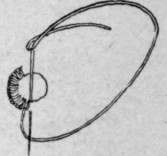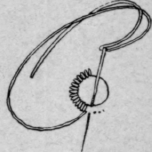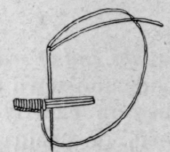Lesson VIII. Eyelet Holes. Loops. Hooks And Eyes
Description
This section is from the book "Educational Needlecraft", by Margaret Swanson And Ann MacBeth. Also available from Amazon: Educational Needlecraft.
Lesson VIII. Eyelet Holes. Loops. Hooks And Eyes
Age : 12-14 Years
As already suggested, the skirt may be fastened at the waist by a draw string.
This necessitates small holes for drawing through the string, known as eyelet holes.
Method
Pierce the single material with a sharp-pointed round tool like a shoemaker's awl, and either top-sew very thickly or button-hole stitch the edges.
The button-hole knots should lie on the material and not at the edge (Diag. 89).
For hooks and lacing, the eyelet holes are worked through double material. The eyelet hole should be top-sewn in order that the hook may lie perfectly flat (Diag. 89A).
Eyelet loops are used with hooks and buttons.
Diag. 89.


Diag. 89A.
Diag. 90.


Diag. 90A.
Four or five strands are sewn quite flat across the material for hooks (Diag. 90), or loosely at the edge of a band for buttons (Diag. 90A), and afterwards covered and strengthened with button-hole stitchery (Diag. 90a).
Eyelet holes can be practised as a simple decorative motif on the necks of chemises, etc. (Diags. 91, 67a).
Hooks And Eyes
These are made in different sizes : small for neckbands, medium for blouses, large for skirt waistbands and garments made of thick material.
There is a quality called the " washing " hook, which though more expensive does not rust in washing. Ordinary hooks and eyes should not be used on washing fabrics, because of the iron mould stains.
Strong thread should be used; the rings and shanks top-sewn (Diag. 92).
When hooks and eyes are not covered with a facing, they should be button-holed instead of top-sewn.
Some prefer to have the entire edges covered to prevent any of the metal showing on the right side (Diag. 92).

Diag. 91. Diag. 92
(Patent fasteners form a very popular method of fastening. They are small circular buttons, the convex structure of the one fits into the concave of the other very neatly. These are sewn on by strong hemming.)
Continue to:


